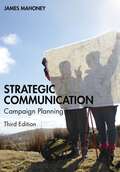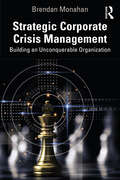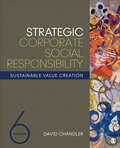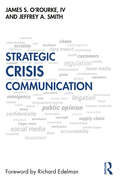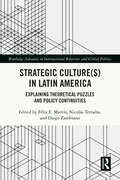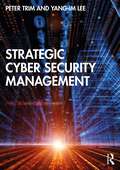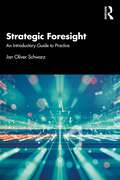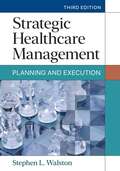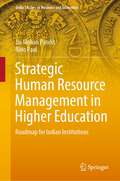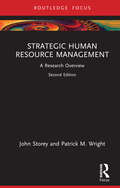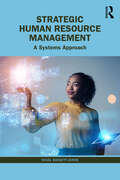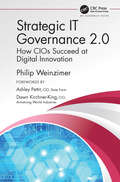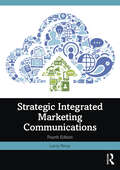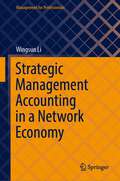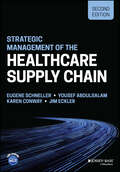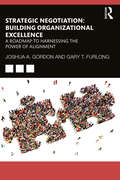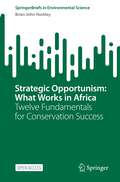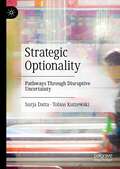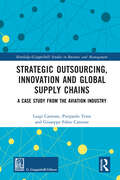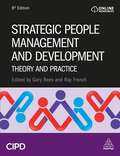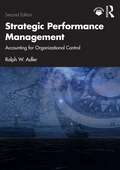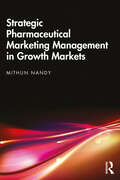- Table View
- List View
Strategic Communication: Campaign Planning
by James MahoneyStrategic Communication deals with the principles behind strategic communication planning. It covers the professional practice steps involved in researching, planning, writing, evaluating and implementing a communication strategy. This book links strategic communication campaign planning to medium and long-term business activity and to how organisations deal with issues. This thoroughly revised third edition includes: New international cases and professional exercises that will enable students to work through the cases and apply theory to real-life situations; New discussion questions on important aspects of campaign planning; Chapter exercises that encourage students to think more broadly about communication strategy and work through the particular aspects of a strategy; In Theory panels that highlight key theories and demonstrate important links between theory and practice Accessible and comprehensive, this is an essential text for students of professional communication and professionals transitioning into the field of Strategic Communication.
Strategic Corporate Crisis Management: Building an Unconquerable Organization
by Brendan MonahanPresenting an alternative to traditional models of centralized crisis management, this book makes the case for decentralizing crisis response and building resilience where it matters most, and provides an accessible, pragmatic approach for doing so. Focusing squarely on crisis management, the book challenges the notion that corporate crisis teams can be expected to swoop in and “save the day”: the role of the crisis team should be to advance a culture of readiness across an organization, and to foster leadership and crisis competency where it’s needed, when it’s needed. Crisis management expert Brendan Monahan draws from current management and leadership thinking that challenges hierarchies, finds incredible potential in the power of an organization’s people, and aligns with many of today’s highest-performing organizations that have already adopted this approach. This may run counter to current crisis management texts prescribing highly disciplined planning and command structures, but following this book’s alternative approach will unlock tremendous potential, deepen resilience, and improve outcomes in crisis response. Professionals in crisis management, business continuity, emergency management, risk management, and others with crisis management accountability will value this practical book for “corporate crisis first responders” to use when they encounter the extraordinary.
Strategic Corporate Social Responsibility: Sustainable Value Creation
by David ChandlerStrategic Corporate Social Responsibility: Sustainable Value Creation (Sixth Edition) redefines corporate social responsibility (CSR) as being central to the value-creating purpose of the firm. Based on a theory of empowered stakeholders, this bestselling text argues that the responsibility of a corporation is to create value, broadly defined. The primary challenge for managers today is to balance the competing interests of the firm’s stakeholders’ understanding that what they expect today may not be what they will expect tomorrow. This tension is what makes CSR so complex and demanding, but it is also what makes CSR integral to the firm’s strategy and day-to-day operations. In this new Sixth Edition, author David Chandler explores issues around COVID-19, the BLM movement, the supply chain crunch, and the "great resignation."
Strategic Corporate Social Responsibility: Sustainable Value Creation
by David ChandlerStrategic Corporate Social Responsibility: Sustainable Value Creation (Sixth Edition) redefines corporate social responsibility (CSR) as being central to the value-creating purpose of the firm. Based on a theory of empowered stakeholders, this bestselling text argues that the responsibility of a corporation is to create value, broadly defined. The primary challenge for managers today is to balance the competing interests of the firm’s stakeholders’ understanding that what they expect today may not be what they will expect tomorrow. This tension is what makes CSR so complex and demanding, but it is also what makes CSR integral to the firm’s strategy and day-to-day operations. In this new Sixth Edition, author David Chandler explores issues around COVID-19, the BLM movement, the supply chain crunch, and the "great resignation."
Strategic Crisis Communication
by Jeffrey Smith James S O'RourkeAddressing 21st-century issues, threats, and opportunities with time-tested principles, this book empowers corporate communications professionals to protect, inspire, and energize organizations in the face of a crisis. Whether due to an external incident or an internal misstep, every major company or institution will find itself scrutinized, its normal operations disrupted, and its reputation and business continuity threatened at some point—and how it prepares for, and reacts to, a crisis can make a critical difference in the ultimate outcome of events. This book focuses on strategic crisis communication as a function of three elements: 1. crisis preparation—establishing a robust and nimble infrastructure and plans, in advance of any crisis 2. crisis management—rapidly gathering information, activating and adjusting plans, making decisions, and relentlessly monitoring outcomes 3. crisis communication—reaching multiple audiences, on multiple platforms, with clear, consistent, and purposeful messages that tell the truth and defend the organization. Bringing together best practices gleaned from hundreds of recent case studies, this book is an unmatched resource enabling corporate communications and PR professionals, and the organizations that employ them, to understand how to weather any reputational storm that may threaten their enterprise.
Strategic Culture Hacks: A Framework for Shaping Corporate Culture
by Josef HergetCulture Hacks are the agile instrument to fill the desired corporate culture with life in the daily business routine.They keep the postulated values present and provide the necessary reflection of daily actions. Culture Hacks address the mindset and the concrete behavior, thus making the corporate culture tangible for all employees at every level of the hierarchy. This book is dedicated to this topic, which is increasingly perceived as important. Culture hacks represent an important element in shaping corporate culture. The topic is still relatively new, and the book is the first to present a comprehensive concept for the strategic use of culture hacks. It creates the link between corporate strategies and operational processes. The concept presented is very pragmatic: concrete models, tools, design principles and roadmaps clarify and accompany the implementation in operational practice. The book creates a framework for the targeted and strategic use of culture hacks to optimize corporate culture.The book is aimed at all managers and employees involved in corporate culture.The reader can expect the following content points: What are Culture Hacks?Strategic Hacks - Nudging - Tips & Tricks Irritations and pattern breaks as ways to change behaviorMindset and behavior - addressees of interventionsImpulses through and for New Work, Management 3.0 and AgilityCulture hacks as a guerrilla strategyProven design principles - suitable fields of application Personal and organizational maturity levelsHow they can be integrated into everyday business lifeInventory and roadmaps - Drawing from a pool of knowledgeDynamic design of culture hack strategiesWith digressions on Paradoxical Intervention, Empathy, Psychological safety, mindset and behaviorSuccessful implementation - Do's and Don't'sNumerous examples illustrate the procedure
Strategic Culture: Explaining Theoretical Puzzles and Policy Continuities (Routledge Advances in International Relations and Global Politics)
by Félix E. Martín Nicolás Terradas Diego ZambranoStrategic Culture(s) in Latin America elucidates why many state-actors in the Global South exhibit a remarkable degree of policy continuity in their external behavior despite structural incentives for change. This book contends that the theoretical notion of strategic culture is instructive to explain such a puzzle. It extends the application of strategic culture beyond the policy of nuclear deterrence among great powers into other equally strategic areas of policy, such as diplomacy, political economy, regional international institutions, legal norms, politico-military institutions, and different security agendas beyond war and peace, for example, the illicit drug-trade and peacekeeping missions. The overall contribution of this book is three-fold: first, it rescues, updates, and expands the original conceptual and theoretical dimensions of strategic culture. Second, it extrapolates further theoretical implications of the concept through its application to five policy domains in Latin America beyond the original application of the strategic culture perspective to nuclear weapons strategy among great powers in the 1970s. Third, it draws together the theoretical and policy implications of the strategic cultures in Latin America and identifies possible applications for other peripheral, non-great power policy areas and issues in the Global South. This book will be of interest to academics, graduate and undergraduate students, policy analysts, and practitioners of Latin American Studies, International Relations Theory and Security Studies.
Strategic Cyber Security Management
by Peter Trim Yang-Im LeeThis textbook places cyber security management within an organizational and strategic framework, enabling students to develop their knowledge and skills for a future career. The reader will learn to: • evaluate different types of cyber risk • carry out a threat analysis and place cyber threats in order of severity • formulate appropriate cyber security management policy • establish an organization-specific intelligence framework and security culture • devise and implement a cyber security awareness programme • integrate cyber security within an organization’s operating system Learning objectives, chapter summaries and further reading in each chapter provide structure and routes to further in-depth research. Firm theoretical grounding is coupled with short problem-based case studies reflecting a range of organizations and perspectives, illustrating how the theory translates to practice, with each case study followed by a set of questions to encourage understanding and analysis. Non-technical and comprehensive, this textbook shows final year undergraduate students and postgraduate students of Cyber Security Management, as well as reflective practitioners, how to adopt a pro-active approach to the management of cyber security. Online resources include PowerPoint slides, an instructor’s manual and a test bank of questions.
Strategic Foresight: An Introductory Guide to Practice
by Jan Oliver SchwarzOrganisations today are being challenged to make sense of changes in environments that, now more than ever, are described as VUCA (volatile, uncertain, complex, and ambiguous). They are also being driven to understand how the future will evolve and what impact it will have not only on the organisations themselves but also on industries and societies. In recent decades a field has emerged to support organisations in addressing these challenges: strategic foresight. This book is a comprehensive introduction to strategic foresight. It presents a history of the field and explains the main principles in thinking about the future. The book describes how organisations can apply strategic foresight and explains how it relates to other fields such as strategy, innovation, and leadership, highlighting the relevance of strategic foresight not only for organisations but also for individuals, particularly managers and leaders. Grounded in the theoretical foundations of strategic foresight, the book reflects the latest academic research and explores practical applications in different contexts. It draws on more than two decades of experience that the author has in the field as a researcher and as a consultant in the corporate context. This is essential reading for managers and leaders of public and private organisations who want to establish strategic foresight practices, as well as students of foresight and managers in the fields of innovation, research & development, and marketing.
Strategic Healthcare Management: Planning and Execution
by Stephen L. WalstonDeveloping and implementing strategy is one of the most challenging tasks for healthcare leaders, as it requires a wide range of skills and knowledge. Strategic Healthcare Management: Planning and Execution provides a thorough overview of strategic principles and the competencies needed to apply them, such as communication, decision making, goal setting, data analyses, project management, and financial analysis. The book emphasizes both competitive and collaborative strategies to help healthcare leaders further their organization's mission rather than merely outperform competitors. <p><p>The third edition includes 10 brand-new cases and expanded content, including new chapters on: <p>• The growing trend of healthcare data analytics, with emphasis on data-driven strategic analysis <p>• Project management principles to support strategy implementation, with an exploration of tools and techniques such as Gantt charts.
Strategic Human Resource Management in Higher Education: Roadmap for Indian Institutions (India Studies in Business and Economics)
by Jai Mohan Pandit Bino PaulThis book explores the practices and policies of human resource management (HRM) in higher education institutions (HEI), while also analyzing the governance and structural challenges. It explains the assessment of university as an organization, outlining the distinction between universities and firms from an HRM point of view by analysing various objectives, parameters and outcomes. The book broadly probes the relevance of HRM systems in HEIs in India and their potential impact. It also examines whether existing HRM practices and policies in HEIs in India drive motivation and enable employees to perform their functions to achieve the highest possible levels of excellence. It explores whether the enhanced motivation of employees consistently impacts students, their placements, progress to higher education, and quality teaching and research output. To strengthen the research output, to better understand the functioning of HRM practices in foreign HEIs and for comparative reasons, the book also studies HEIs in the United States against a diverse set of HEIs in India. It concludes by highlighting the impact of India’s National Education Policy 2020 and its scope to transform and professionalise the higher education system in the country. The book is indispensable for researchers in education management and policy studies and those in governing positions in higher education institutions. It is also a valuable resource for regulatory and government bodies, and policy-formulating think tanks in South Asia which have a similar education system as India.
Strategic Human Resource Management: A Research Overview (State of the Art in Business Research)
by John Storey Patrick M. WrightThe second edition of this popular shortform book provides a concise expert summary of key issues in the theory and practice of the management of human resources (HR) – one of the most crucial drivers of organizational performance. As human resource management strategies evolve over time, this new edition pays special regard to the HR challenges arising from radically altering contexts – economic, social, and technological. For example, the book examines research reports on the impact of the COVID pandemic and other disruptions to the global world of work. It assesses recent HR initiatives and priorities such as Equality, Diversity and Inclusion (EDI) and the HR implications of remote and hybrid working. The book evaluates contemporary critiques that HR practice and research can be part of the problem. In sum, the book offers a route map through the extensive terrain of contemporary research project findings. Serving as a unique researcher’s guide, this concise book enables readers to develop their own ideas for future research and such is essential reading for management scholars and reflective practitioners.
Strategic Human Resource Management: A Systems Approach
by Nigel Bassett-JonesThis innovative text applies a systems theory perspective to strategic human resource management, drawing particularly on the Viable System Model and soft systems methodology. Readers are introduced to different ways of thinking about systems and shown how systems can interact, triggering changes in the competitive environment – and how HR systems can either facilitate or inhibit adaptation to these changes. Peppered with international examples throughout, this book considers key HR topics such as recruitment, reward, employment relations, culture, diversity and leadership, all through a systems lens. It shows how an understanding of system dynamics can help managers to recognise complexity, accept the inevitability of short-term systemic conflicts and anticipate the likely consequences. This text will be suitable for upper-level undergraduate, postgraduate and MBA students of strategic HRM, HRM and strategic management. It will also be thought-provoking for HR professionals looking to embrace a strategic role in their organizations.
Strategic IT Governance 2.0: How CIOs Succeed at Digital Innovation
by Philip WeinzimerWeinzimer provides industry case studies of companies that have implemented multiple components of The Strategic IT Governance 2.0 model. These companies successfully leveraged collaboration between technology and the business to deliver technology projects that provide the best customer value, improve cost efficiencies, and create a governance culture across business areas. In his book, you will learn valuable lessons to implement an innovative governance model for your company.— Ashley Pettit, CIO, and Senior Vice President, Enterprise Technology, State Farm In Strategic IT Governance 2.0, Phil provides a number of exciting case studies of how CIOs are leveraging technology to innovate and create value. They are following Phil's model, building strategic and tactical relationships within the business to drive technology growth strategies, collaborating with partners to improve customer service and increase value with process optimization and best practice metrics. Each of these companies offers a slightly different take on the multiple components of the Strategic IT Governance 2.0 model; however, these organizations' collective and individual success indicates the strength of the components.— Dawn Kirchner-King, Vice President and Chief Information Officer, Armstrong World Industries Today's business environment is more complicated, creating additional challenges for the successful execution of strategic enterprise projects. Unless an organization revisits its governance model, strategic projects are at risk of negatively impacting business success. So, how do companies succeed in overcoming these obstacles to improve project success? Strategic IT Governance 2.0: How CIOs Succeed at Digital Innovation explains how IT executives can take the lead and successfully drive digital transformation initiatives and associated projects. The book presents the Strategic IT Governance 2.0 model that focuses on project alignment, process reinvention, and leadership excellence. It is filled with case studies of the model’s implementation, giving practical insight into how organizations have successfully executed digital transformation.
Strategic Integrated Marketing Communications
by Larry PercyThis book provides a disciplined, systematic look at what is necessary to the planning and implementation of an effective Integrated Marketing Communications (IMC) programme. Throughout, attention is paid to balancing theory with practical application, how to successfully implement theory for effective communication. Step-by-step, knowledge and understanding builds through the book, starting by laying a foundation to provide context, looking at the role of IMC in building brands and strengthening companies. The book then considers what goes into developing and executing effective messages, and how to ensure that they are consistent and consistently delivered, regardless of media. A detailed, practical overview of the strategic planning process is provided, illustrated by numerous examples and cases, along with ‘desktop’ tools and worksheets for developing and implementing an IMC plan. The 4th edition of this classic textbook has been fully updated throughout, and includes: • Updated and expanded coverage of digital media, including issues relating to privacy and media strategy. • New sections on setting campaign budgets, brand architecture, target audience action objectives, social marketing communication, and such practices as gamification and experiential marketing. • Extended content on international advertising and shared cultural values. • The introduction of a channels-based typology of marketing communication. • Updated international examples and case studies throughout. A comprehensive and accessible guide to the steps of planning and developing an effective IMC campaign, this book should be core reading for students studying Integrated Marketing Communications, Strategic Communications, Principles of Advertising, Media Planning and Brand Management.
Strategic Management Accounting in a Network Economy (Management for Professionals)
by Wingsun LiThis book continues from author’s first SMA publication in 2018 (also by Springer) and discusses the new roles of SMA in the new network economy. Emerging digital technologies have revolutionized the business world with groundbreaking rules and innovative business models. New knowledge and information technologies have inspired new business ideas and created more information platforms at a lower cost, yet highly efficient in the market. The new business transformation also encourages more inter-organizational cooperation to cope with rapid changes. All these novelties add challenges to corporate individuals in managing businesses beyond their organizations, in particular financial professionals (e.g., CFO) who are experts in the team. Therefore, SMA is assigned a new role in the new network economy. Similarly, SMA calls for major updates and revisions. This urges author to write this book to meet the new demand. The author has selected important topics that are particularly pertinent to the new Internet economy. These topics include how to make decisions under business uncertainty, how to value businesses in general, Internet stocks and intangible assets in particular. Business collaboration and integration are usual means to acquire synergy value. How does SMA help deliver the best results? How are business models and information platforms built as sense-making revenue models, even though these platforms never charge for services? How is market power and brand value measured? How does trust supplement control in new network organizations? Finally, how is value created, captured, and allocated in a fair manner? The book goes through detailed examinations of each topic with cases, examples, and illustrations as required.
Strategic Management of the Health Care Supply Chain
by Karen Conway Eugene Schneller Yousef Abdulsalam Jim EcklerA systems approach to understanding the needs of today’s healthcare supply chain Strategic Management of the Healthcare Supply Chain offers a big-picture overview and a proven strategic framework for supply chain management in healthcare. It also addresses concrete strategies for risk management, partnerships, logistics, performance assessment, information technology, and beyond. Readers will gain a comprehensive understanding of the issues facing the healthcare supply chain and the opportunities that present themselves as we look toward the future. Written by a team of authors with both research expertise and practical experience in healthcare supply chain, this broad and impactful book teases out the complexities within the supply chain field and the healthcare ecosystem. The healthcare industry is evolving rapidly, and the role of the supply chain is shifting in response. Institutions and practitioners are collaborating more closely than ever with supply chain leaders. This shift introduces new opportunities and challenges at the level of healthcare delivery. Additionally, the role of supply chain in safeguarding the social determinants of health—food, transportation, critical health-related products—is rapidly expanding, especially in historically underserved populations. This revised edition takes a holistic approach to the needs of people and organizations, yielding strategies that will improve both economic and health outcomes. Gain the understanding you need to work toward building a mature supply chain organization Develop perspective on how the needs of the healthcare supply chain are shifting in the modern era Holistically assess supply chain performance and improve clinical, financial, and operational outcomes Identify opportunities to generate value, improve alliances, and cut costsThis book will be of interest to graduate students in the health sector and supply chain programs, as well as working clinicians, health sector managers, and supply chain leaders. Policymakers looking to create a more resilient healthcare supply chain in the wake of COVID-19 will also find valuable insight inside.
Strategic Negotiation: A Roadmap to Harnessing The Power of Alignment
by Gary T. Furlong Joshua A. GordonEmpowering organizations to thrive, this book provides a clear diagnostic framework with specific approaches and processes that leaders can use to build a negotiation function that will succeed each and every time.Negotiation is a required skill and a core competency, but most organizations focus exclusively on individual negotiation skills and abilities and pay little attention to the internal culture and environment that shapes and guides these individuals. This book takes a dramatically different approach to building success in each and every negotiation, producing results that align with organizational strategy at all levels. Professionals in sales, procurement and supply chain, human resources, change management, mergers and acquisitions, contracts, start-ups, construction partnering, and training consultants and students of business and law will value a text that understands how to build negotiation skills and capability across the organization by aligning individual skills with an evidence-based approach that actually works.
Strategic Negotiation: A Roadmap to Harnessing The Power of Alignment
by Gary Furlong Joshua GordonEmpowering organizations to thrive, this book provides a clear diagnostic framework with specific approaches and processes that leaders can use to build a negotiation function that will succeed each and every time.Negotiation is a required skill and a core competency, but most organizations focus exclusively on individual negotiation skills and abilities and pay little attention to the internal culture and environment that shapes and guides these individuals. This book takes a dramatically different approach to building success in each and every negotiation, producing results that align with organizational strategy at all levels.Professionals in sales, procurement and supply chain, human resources, change management, mergers and acquisitions, contracts, start-ups, construction partnering, and training consultants and students of business and law will value a text that understands how to build negotiation skills and capability across the organization by aligning individual skills with an evidence-based approach that actually works.
Strategic Opportunism: Twelve Fundamentals for Conservation Success (SpringerBriefs in Environmental Science)
by Brian John HuntleyThis open access book. provides a synthesis of six projects, across ten countries, each of which have been sustained for two or more decades, and which illustrate how success can be achieved regardless of systems of governance, of a nation’s wealth, or of culture. Detailed narratives are presented on the key personalities that have conceived, conducted and concluded long-term projects: personal stories of vision, failure, frustration and persistence ultimately leading to success.The case studies vary widely in their geography and goals. The single-handed commitment to re-discover the last surviving populations of Giant Sable in the miombo woodlands of central Angola, through the capture, translocation and establishment of robust breeding herds of this magnificent antelope, contrasts with the massively funded, three-decade programme with over one hundred participants that reversed the annual loss to predation by feral cats of 455 000 seabirds from a sub-Antarctic island. Similarly, the foresight of Zimbabwean and Namibian ecologists to place rural communities at the centre of conservation programmes by giving value to wildlife populations and benefits to local people, transformed a land degradation problem to a socio-ecological solution. Across ten countries, building capacity in botanical collection, documentation and herbarium management expanded into a global project to place the knowledge base of Africa’s flora onto an electronic data system accessible to researchers and conservation planners in even the most remote corners of the continent. None of these projects enjoyed immediate results. Each required leadership skills that combined vision, a generosity of spirit, fortuitous timing and the exploitation of unexpected opportunities.
Strategic Optionality: Pathways Through Disruptive Uncertainty
by Surja Datta Tobias KutzewskiThis book offers a fresh approach to strategy by examining the idea of Optionality. Optionality is the right, but not the obligation, to take an action. Built on historic military tactics, static engineering principles, and equilibrium-seeking economics, conventional strategic-thinking suffers some weaknesses, principal of which is its inability to deal with conditions of high uncertainty. This book begins by dividing the business landscape into three distinct domains; (1) Fragile, (2) Robust, and (3) Long-shot (FRL), which alert us to the context-specificity of strategy tools, before suggesting that theoretical lenses are required to understand and implement strategy in VUCA (Volatile, Uncertain, Complex, and Ambiguous) domains. The authors explore the concept and methodology of Optionality in order to demonstrate how it can be used in conjunction with existing strategy tools in order to achieve competitive success. It will be of great interest to academics and students of strategy and innovation.
Strategic Outsourcing, Innovation and Global Supply Chains: A Case Study from the Aviation Industry (Routledge-Giappichelli Studies in Business and Management)
by Luigi Cantone Pierpaolo Testa Giuseppe Fabio CantoneDecision-making on outsourcing new product development (especially innovation projects), such as engaging and managing the supply chain, is far from easy. It may involve addressing strategic and operational risks that might cause longer development times and increase innovations costs. It is, therefore, imperative to select suppliers very carefully and set up an effective management strategy vis-à-vis the supply partners right from the inception phase. Supply chain management is facing enormous challenges, driven by interrelated disruptions that will have a vast and lasting impact. Based on a relevant case study, Boeing 787 Dreamliner programme, this volume offers a comprehensive overview of the decision-making models for outsourcing strategic activities. The proposed model suggests a valuable approach to outsourcing the decision-making strategies for new product development when the innovation is driven by technological innovation.
Strategic People Management and Development: Theory and Practice
by Gary Rees and Ray FrenchStrategic People Management and Development maps to the CIPD Level 7 module 'People Management and Development strategies for performance'. It focuses on the need for evidence-based and outcome-driven practice in the people profession and explains how HR and Learning and Development (L&D) professionals can create value and drive performance in an organisation. It provides a thorough grounding in the theory and practice of how to lead and manage employees and effectively develop a workforce as well as extensive coverage of how to ensure professionalism and ethical behaviour in the people function. This book also includes discussion of organisation development and how high-performance work practices drive positive organisational and employee outcomes. This book also includes practical advice on key HR activities including recruitment, job design,and reward. Fully updated throughout, this book includes case studies to help students see how the theory applies in practice, reflective practice activities to help them think critically about the content and self-test their learning progress as well as 'explore further' boxes to encourage wider reading. Online resources include an instructor's manual, lecture slides, and sample essay questions.
Strategic Performance Management: Accounting for Organizational Control
by Ralph W. AdlerEffective performance management is core to successful organizations. The new edition continues to look at performance management as an interdisciplinary field of study and practice and draws upon a wide set of business disciplines, including strategic management, organizational behaviour, organizational theory, and management accounting. The book provides a contemporary examination of theories, issues, and practices related to performance management with an original performance management framework, grounded in concrete organizational phenomena, therefore making it more accessible and meaningful to practitioners, scholars, and students. The updated edition also examines organizations’ evolving use of digital business transformation and the effect on performance management design. With updated cases, the latest edition will help readers to gain insights into the fields of strategic management, organizational behaviour, organizational theory, and management accounting and how they contribute to the study and practice of performance management.
Strategic Pharmaceutical Marketing Management in Growth Markets
by Mithun NandyIndia is the largest provider of generic drugs globally. The Indian pharmaceutical sector supplies over 50% of the global demand for various vaccines and, as a result, holds an important position in the global pharmaceutical sector. This book is a comprehensive study of pharmaceutical marketing management in the Indian context and similar growth markets. The book introduces the fast-paced and multi-faceted discipline of pharmaceutical marketing management through an in-depth discussion on the genesis and evolution of its marketing concept. Combining theory and practice, it offers a strategic approach to pharmaceutical marketing from an organizational and business perspective and explicates the practical applications of it. Richly supported by case studies, the book brings together fresh perspectives and approaches equally useful for students and professionals. This book will be of interest to academicians, advanced students, and practitioners of pharmaceutical marketing and pharmaceutical management. It will also be beneficial to those interested in business strategy, decision-making, and international marketing.
